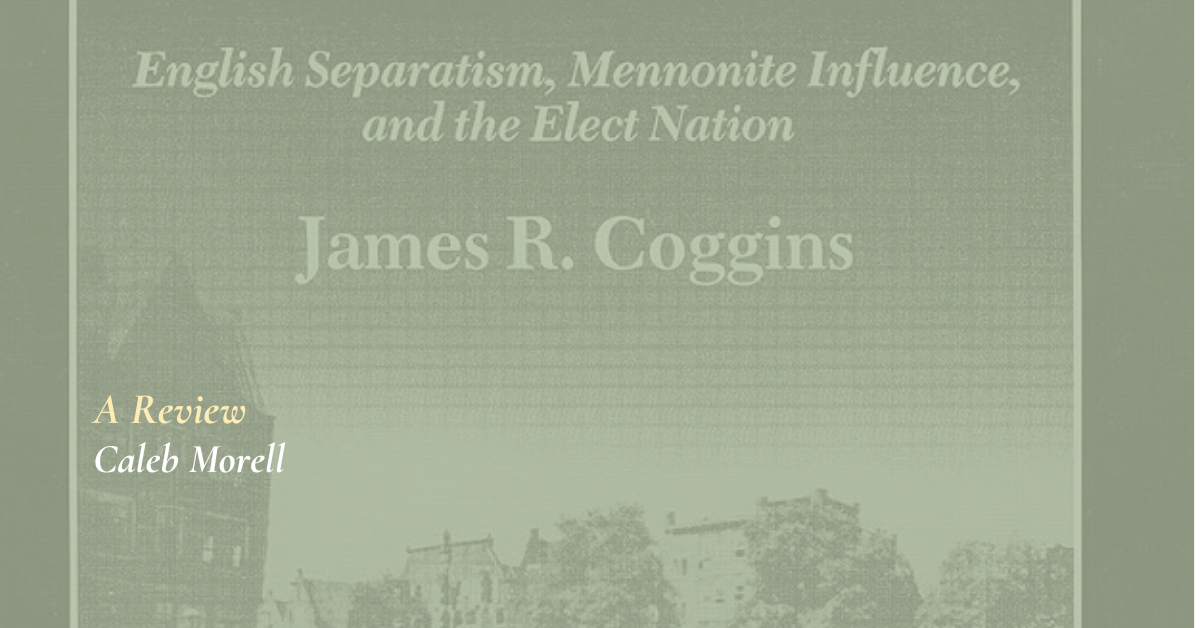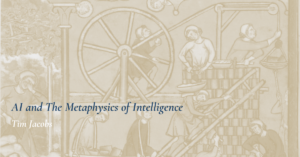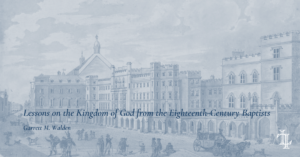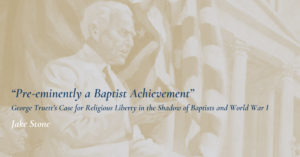Coggins, James R., John Smyth’s Congregation: English Separatism, Mennonite Influence, and the Elect Nation (Waterloo, Ontario: Herald Press, 1991).
Reading James R. Coggins well-researched monograph, John Smyth’s Congregation: English Separatism, Mennonite Influence, and the Elect Nation (Waterloo, Ontario: Herald Press, 1991), provides a window through which to understand the origins of English Baptists out of the Puritan Separatist movement of the early seventeenth century.
Coggins discoveries in the Mennonite archives in Amsterdam shed light on the fascinating transformation of the Smyth congregation from an illegal Separatist conventicle in Lincolnshire, England to formally merging with a Dutch-speaking Mennonite congregation in Amsterdam. This transformation caused a split in the Mennonite Bevredigde Broederschap alliance and led to the formation of two congregations: one led by John Smyth, which merged with the Mennonites and quickly faded from memory, and the other, led by Thomas Helwys, which remained Baptist, returned to England, and grew into the Baptist movement that remains to this day.
The Smyth congregation is known for being the earliest known English-speaking Baptist church. However, far more importantly, the Smyth congregation was a model of how believer’s baptism developed among the English Puritans, as a logical outflow of their conviction that the church was a community of saints covenanted together to live faithfully to God’s Word. So rather than wading into the acrimonious debate over “whether Baptists were Anabaptists or Protestants” this review of sorts will simply seek to spell out what Coggins has to say about the ecclesiological logic through which the Smyth congregation became Baptist (24).
To explain how these ideas emerged, some brief historical context is required. At that time in English history the state of the church was almost singularly subject to the whims of the reigning monarch. For King James I (r. 1603-1625), whose ecclesiological persuasions were aggravated by his upbringing in Presbyterian Scotland, where, to quote James, even the King was subject to the judgments of “every Tom, Dick, and Harry,” Puritanism posed a threat to royal supremacy. His ecclesiological convictions could be summed up with the simple aphorism, “No bishop, no king” (28). Unsurprisingly, then, and much to the disappointment of the Puritan clergy, the King’s official decree at the Hampton Court Conference in 1604 declared that Episcopalian polity would continue to be the Church of England’s form of church government.
The ministers who refused to subscribe to James I’s doctrines of royal supremacy, the Thirty-nine Articles, Episcopal church government, and the Book of Common Prayer were deprived of their positions. Around three hundred refused initially, but many buckled under pressure. Only about ninety ministers held out and were deprived of their positions (31). They became known as “Separatists” over their conviction of the need to separate from the Church of England. Out of these ministers, and the followers they attracted, grew a movement of Separatist congregations in early-modern England. In contrast to earlier groups, “a considerable proportion of each congregation were clergy” (31). As Coggins demonstrates, they were not gatherings of ignorant farmers, but congregations of educated members of the gentry class where “many members could be expected to preach and teach” (31).
The central principle to which these Separatists held was an understanding of the church where members were bound together, not by geography or nationality, but by entering into a covenant with one another. For them, the covenant was what constituted a church. A couple of implications flowed from this: First, there was no external authority over the local congregation (i.e. Episcopacy). Second, every member was equally responsible for the work of the church and upholding the covenant. These were the convictions that developed among the Puritans in early seventeenth-century England, and it was from these gatherings of dispossessed ministers and disgruntled members that the first known baptistic church in England emerged. In the town of Gainsborough in Lincolnshire, the congregation generally known as the “Smyth congregation” covenanted as a church sometime around 1606-1607 (33). In the words of their original church covenant:
As the Lords free people joined themselves (by a covenant of the Lord) into a Church estate, in the fellowship of the gospel, to walke in all his ways made known, or to be made known unto them, according to their best endeavours, whatsoever it should cost them, the Lord assisting them (33).1Coggins finds this covenant so similar to the covenant of the Ancient Church in 1591 that he wonders if Smythe was influenced by the work of his former Cambridge tutor Francis Johnson (34). The Covenant of the Ancient Church reads: “Wee doe willinglie joyne together ot live as the Churche of Christs… To this ende wee doe promise henceforthe to keep what soever Christe our Lorde gath commanded us, as it shall please him by his holie spirit out of his wode to give knowledge thereof and abilitie there unto” (34).
As Puritan Separatists, they understood themselves to be “a new church formed by church covenant” (34). The covenant created the church. This covenant worked in two directions: members were bound to one another (“into a Church estate, in the fellowship of the gospell”) and to God (“to walke in all his ways, made known, or to be made known unto them, according to their best endeavours”). Underscoring the mutual responsibility of the members to uphold the church covenant, of the forty-three members of the “Smythe Congregation,” all signed the church confession and statement of faith (36). At this stage in time, they were simply a Puritan Separatist church, practicing infant baptism like other Separatist congregations (they did not cease the practice of infant baptism and begin to practice believer’s baptism until a few years later).
As far as church government was concerned, Smyth argued in The Differences of the Churches of the separation (1608) “that there should normally be a plurality of elders in a congregation” (35, 50). Far from a theoretical ideal, the Smyth congregation actually had at least five elders who normally preached. Smyth could write to one friend that there were several “Prophets and Teachers of our Church” (35). The church statement of faith was thoroughly congregationalist, and it stated “that each congregation could appoint officers and administer the sacraments” (104). In fact, based on the fact that they were required to sign the church covenant, Coggins argues that even the women were allowed to vote in elections and matters of discipline (127). Article 20 of the statement affirmed that “there were only two church offices of elder and deacon” (105). And while the office of elder was reserved for biblically qualified men, women could serve in the office of deaconess, responsible for meeting physical needs in the church.2Smyth, Works 1:256. Cited in Coggins, 126.
What you see, then, in the Smyth congregation, is the essence of Puritanism in miniature: a commitment to do what it takes to reform the local church to faithfully practice discipline and membership according to an agreed upon church covenant.
What distinguishes the Smyth congregation from other Separatist congregations is how their commitment to congregationalist ecclesiology led to their adoption of believer’s baptism. The order of events is crucial: they were not first Baptists who decided to become congregationalists. They were congregationalists who became Baptists, not in spite of their congregationalism but because of it.3This is also the argument put forward in Matthew C. Bingham in Orthodox Radicals: Baptist Identity in the English Revolution (Oxford University Press, 2019). Coggins accurately summarized the process as follows: “Their ideal was the congregation of true believers voluntarily committed to each other and to God, and believer’s baptism was merely a sign of this, or a method of implementing it” (106). In other words, Smyth’s congregation came to understand believer’s baptism to be the logical result of covenanting together as a church. If a church is to be composed of those covenanted together and only believers can truly covenant together, then it follows that only believers ought to be baptized into membership. To quote Coggins again, the Smyth congregation “regarded believer’s baptism as only a more purified form of the Separatist covenant” (106). The difference between the Smyth congregation and other Separatist Puritans then came down to this: “The puritans did not want to baptize only believers. Their agenda was to make all the baptized into believers” (146).4It is important to note that I am strictly referring to “believer’s baptism” rather than believer’s baptism by immersion. As Coggins rightly observes, it was not until decades later Baptists began to defend the “newly discovered doctrine of baptism by immersion” (106). Baptists have historically understood the subject (a believer) rather than the mode (immersion) to be essential to baptism.
To conclude, the Smyth congregation was far more than the earliest known English-speaking Baptist church. It was also a real-life example of how believer’s baptism developed among the English Puritans as a logical outgrowth of their understanding of the local church, as a community of saints covenanted together to live faithfully to God’s Word. As such, it is not surprising in the least that Baptist churches began to emerge all over England in the seventeenth century, with no apparent connection to John Smyth’s congregation. In these Baptist congregations, the practice of believer’s baptism flowed naturally out of the commitment to covenant as believers in the local church.
[1] Coggins finds this covenant so similar to the covenant of the Ancient Church in 1591 that he wonders if Smythe was influenced by the work of his former Cambridge tutor Francis Johnson (34). The Covenant of the Ancient Church reads: “Wee doe willinglie joyne together ot live as the Churche of Christs… To this ende wee doe promise henceforthe to keep what soever Christe our Lorde gath commanded us, as it shall please him by his holie spirit out of his wode to give knowledge thereof and abilitie there unto” (34).
[2] Smyth, Works 1:256. Cited in Coggins, 126.
[3] This is also the argument put forward in Matthew C. Bingham in Orthodox Radicals: Baptist Identity in the English Revolution (Oxford University Press, 2019).
[4] It is important to note that I am strictly referring to “believer’s baptism” rather than believer’s baptism by immersion. As Coggins rightly observes, it was not until decades later Baptists began to defend the “newly discovered doctrine of baptism by immersion” (106). Baptists have historically understood the subject (a believer) rather than the mode (immersion) to be essential to baptism.
Author
-

Caleb Morell is a historian and senior pastoral assistant at Capitol Hill Baptist Church in Washington, DC. He graduated magna cum laude from Georgetown University’s School of Foreign Service where he majored in International History and was awarded the Davids Medal for his thesis on the early-English Baptist theological arguments for religious toleration. He completed his Master of Divinity at the Southern Baptist Theological Seminary in Louisville, Kentucky and is currently a doctoral student in historical theology at Midwestern Baptist Theological Seminary in Kansas City, Missouri and an Associate of Newton House, Oxford. His political, theological, and historical writings have appeared at 9Marks, American Reformer, Christ Over All, ERLC, Fairer Disputations, First Things, The Gospel Coalition, Journal of the Evangelical Theological Society, Providence Magazine, SBC Life and World Opinions, and been quoted by The Washington Post. His forthcoming book, A Light on the Hill: The Surprising Story of How a Local Church in the Nation’s Capital Influenced Evangelicalism will be published by Crossway in 2025. He lives with his wife, Clare, and their three children on Capitol Hill.
View all posts



